Creating a green home office isn't just about eco-friendly choices; it's about smart energy use too. Start by maximizing natural light and using LED bulbs for energy-efficient lighting. Choose sustainable furniture made from renewable materials or opt for second-hand pieces. Invest in Energy Star certified electronics and use smart power strips to eliminate phantom energy draw. Natural insulation like eco-friendly window treatments and indoor plants can help control temperature. Get creative with upcycled office accessories, and add air-purifying plants to boost air quality. These energy-smart decor ideas will transform your workspace into an eco-conscious haven. Dive deeper to discover how each element contributes to a greener office environment.
Eco-Friendly Lighting Solutions

How can you illuminate your home office while minimizing your environmental impact? Start by maximizing natural light. Position your desk near a window and use light-colored, reflective surfaces to bounce daylight around the room.
When artificial lighting is necessary, opt for LED bulbs, which use up to 75% less energy than traditional incandescent bulbs and last much longer.
Consider installing smart lighting systems that automatically adjust brightness based on ambient light levels or your daily routines. Motion sensors can help guarantee lights aren't left on in unoccupied spaces.
For task lighting, choose energy-efficient desk lamps with adjustable arms to direct light precisely where you need it.
Don't overlook the power of accent lighting. Use LED strip lights to create a warm ambiance without consuming excessive energy. Solar-powered desk accessories, like clocks or small lamps, can add functional lighting without increasing your electricity bill.
Remember to properly dispose of old bulbs, especially CFLs which contain small amounts of mercury. Many hardware stores offer recycling programs for used light bulbs.
Sustainable Furniture Choices
Sustainability in furniture selection plays a crucial role in creating an eco-friendly home office. When choosing furniture, opt for pieces made from renewable or recycled materials. Bamboo desks and shelving units are excellent choices, as bamboo grows quickly and doesn't require pesticides.
Reclaimed wood furniture not only looks unique but also reduces deforestation and waste.
Consider investing in modular furniture that can adapt to your changing needs, reducing the likelihood of discarding pieces as your office evolves. Look for furniture with certifications like FSC (Forest Stewardship Council) or GREENGUARD, ensuring responsible sourcing and low chemical emissions.
Don't overlook second-hand options. Vintage or gently used furniture extends the lifecycle of existing pieces and prevents them from ending up in landfills. When buying new, choose high-quality, durable items that will last for years.
For seating, select ergonomic chairs made from recycled materials or natural fabrics. Some manufacturers now offer take-back programs, ensuring proper recycling of old furniture.
Energy-Efficient Electronic Equipment
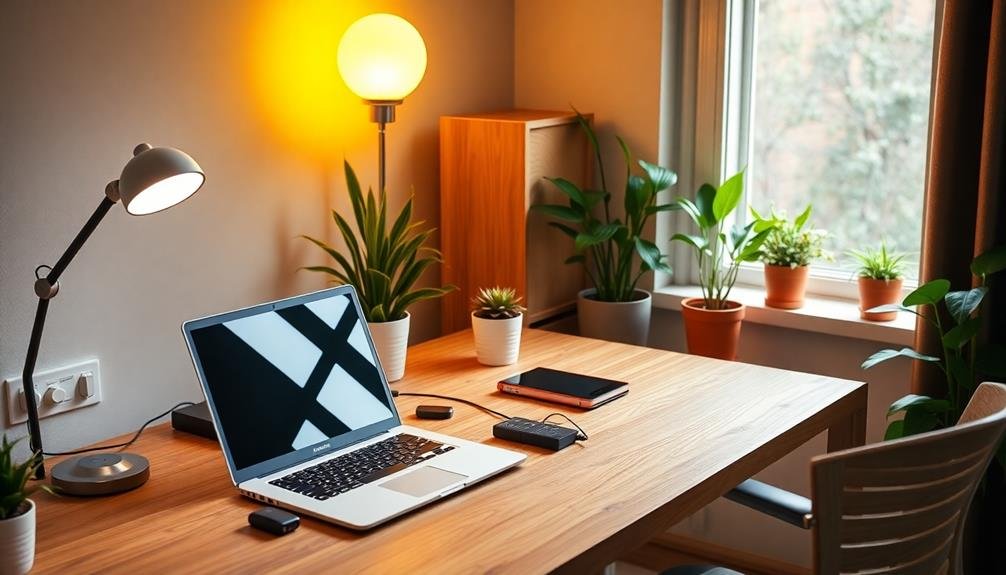
When setting up your eco-friendly home office, don't overlook the importance of energy-efficient electronic equipment.
Start by choosing Energy Star certified devices for your computer, monitor, printer, and other office essentials.
You can further reduce energy consumption by using smart power strips, which automatically cut power to devices in standby mode and help eliminate phantom energy draw.
Energy Star Certified Devices
Energy Star certified devices are an essential component of any eco-friendly home office. These products have been rigorously tested and certified by the U.S. Environmental Protection Agency to meet strict energy efficiency guidelines. By choosing Energy Star certified equipment, you'll reduce your carbon footprint and save money on energy bills.
When shopping for office electronics, look for the distinctive blue Energy Star label. You'll find it on a wide range of products, including computers, monitors, printers, and even light bulbs.
Energy Star certified computers use 60% less electricity than standard models, while certified monitors consume 27% less power.
Don't forget about peripherals like scanners, copiers, and multifunction devices. Energy Star versions of these products can save you up to 40% on energy costs.
Even small items like power strips and surge protectors come in Energy Star certified versions, which automatically cut power to devices in standby mode.
Smart Power Strips
Smart power strips take energy efficiency to the next level. These intelligent devices automatically cut power to electronics when they're not in use, eliminating standby power consumption. You'll find various types of smart power strips, each offering unique features to suit your home office needs.
Some models use motion sensors to detect when you're away from your desk, shutting off connected devices after a set period. Others employ master-slave outlets, where turning off a primary device (like your computer) triggers the strip to cut power to peripherals (such as monitors or printers).
Look for smart power strips with surge protection to safeguard your electronics from voltage spikes. Many also come with USB charging ports, allowing you to consolidate your charging needs into one convenient location.
When selecting a smart power strip, consider the number of outlets you'll need and the types of devices you'll connect. Some strips offer customizable settings, letting you program specific on/off schedules for different outlets.
This feature can be particularly useful if you have equipment that needs to run at specific times, like a backup system or a device that requires regular updates.
Natural Insulation and Temperature Control
You can naturally regulate your home office temperature with eco-friendly window treatments, indoor plants, and natural fiber carpeting.
Insulating curtains or blinds made from sustainable materials help keep heat in during winter and out during summer.
Adding plants not only purifies the air but also cools the room, while natural fiber rugs provide insulation and comfort underfoot.
Eco-Friendly Window Treatments
Window treatments play an essential role in creating an eco-friendly home office. They not only enhance your workspace's aesthetics but also contribute to energy efficiency and sustainability.
Opt for natural, biodegradable materials like bamboo or organic cotton for your curtains and blinds. These choices reduce your carbon footprint and improve indoor air quality.
Consider installing cellular shades, which trap air between layers, providing excellent insulation. They'll help regulate temperature, reducing your reliance on heating and cooling systems.
For added energy savings, choose light-colored window treatments that reflect sunlight, keeping your office cooler in summer.
Don't overlook the power of plantation shutters made from sustainable wood or recycled materials. They offer precise light control and superior insulation.
If you're tech-savvy, invest in smart blinds that automatically adjust based on sunlight and temperature, maximizing energy efficiency.
For a budget-friendly option, try DIY window films. They block UV rays, reduce glare, and improve insulation without obstructing your view.
Indoor Plants for Cooling
Moving from window treatments to another natural cooling method, indoor plants offer a revitalizing way to regulate your home office temperature. These green companions not only purify the air but also act as natural coolants through transpiration. You'll find that strategically placed plants can reduce indoor temperatures by up to 10 degrees Fahrenheit.
Consider incorporating these cooling plants into your workspace:
| Plant Name | Benefits | Care Level |
|---|---|---|
| Snake Plant | Night-time oxygen release | Low |
| Boston Fern | High humidity production | Medium |
| Spider Plant | Air-purifying powerhouse | Low |
To maximize their cooling effect, place larger plants near windows and computers. You'll notice improved air quality and a more comfortable working environment. Don't forget to mist your plants regularly, as this increases humidity and enhances their cooling properties.
For ideal results, aim for one medium-sized plant per 100 square feet of office space. You'll create a more pleasant, productive atmosphere while reducing your reliance on energy-intensive air conditioning. It's a win-win for both your work life and the environment.
Natural Fiber Carpeting
Natural fiber carpeting offers an eco-friendly solution for insulation and temperature control in your home office. Made from materials like wool, sisal, jute, or seagrass, these carpets provide excellent insulation properties, helping to maintain a comfortable temperature year-round.
They're particularly effective at retaining heat during colder months, reducing your reliance on artificial heating. In warmer weather, natural fiber carpets can help keep your office cool by absorbing excess moisture from the air. This natural humidity control creates a more pleasant work environment and can potentially lower your air conditioning costs.
Additionally, these carpets are biodegradable and often produced using sustainable farming practices, making them a responsible choice for environmentally conscious homeowners.
When selecting natural fiber carpeting for your home office, consider the specific needs of your space. Wool carpets offer superior insulation and durability, while sisal and jute provide a more textured look and feel.
Seagrass is highly resistant to stains and moisture, making it ideal for high-traffic areas. Whichever option you choose, you'll benefit from improved temperature regulation, reduced energy costs, and a stylish, eco-friendly addition to your workspace.
Upcycled Office Accessories
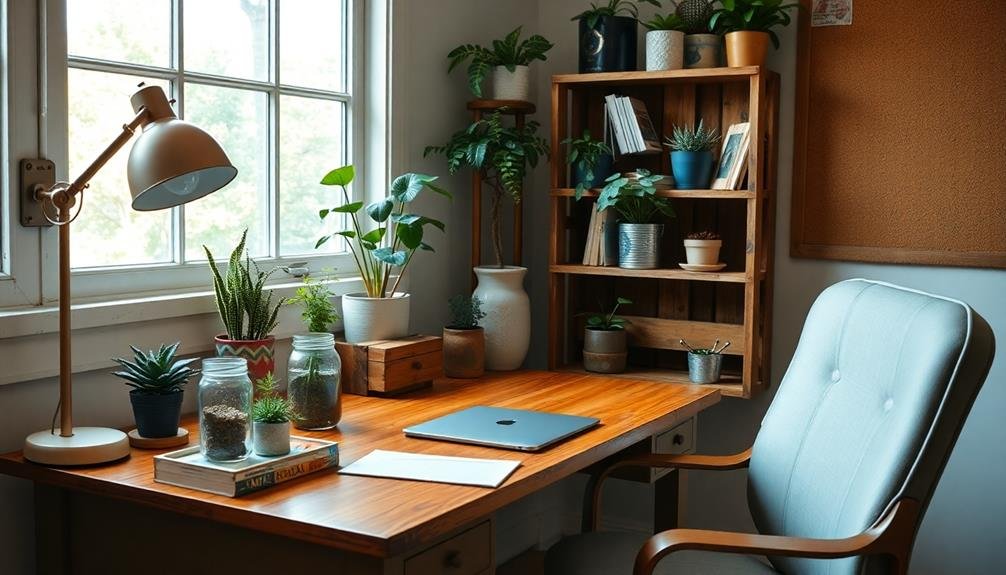
Why settle for mass-produced office accessories when you can create unique, eco-friendly alternatives? Upcycling transforms discarded items into functional office gear, reducing waste and adding character to your workspace.
Get creative with everyday objects: turn old wine corks into a bulletin board, repurpose glass jars as pen holders, or craft a desk organizer from cardboard boxes.
Embrace the art of upcycling by exploring these ideas:
- Convert vintage suitcases into storage units for files and supplies
- Transform old books into hidden storage boxes or laptop stands
- Repurpose wooden pallets to create wall-mounted shelving
- Use empty tin cans as planters for small office plants
Green Plants for Air Purification
Incorporating plants into your home office does more than just complement your upcycled decor; it actively improves your workspace's air quality. NASA's Clean Air Study identified several plants that excel at filtering common indoor air pollutants.
The Snake Plant, also known as Mother-in-Law's Tongue, is a low-maintenance option that thrives in low light and removes formaldehyde, xylene, and toluene from the air. Spider Plants are another easy-care choice, effective at reducing carbon monoxide and xylene levels.
For a pop of color, consider the Peace Lily, which tackles benzene, trichloroethylene, and formaldehyde while producing elegant white flowers. The hardy Pothos is perfect for beginners and helps eliminate formaldehyde.
If you've got ample space and natural light, the Ficus tree is an excellent choice for removing airborne toxins.
When selecting plants, consider your office's lighting conditions and your ability to care for them. Start with one or two plants and gradually increase the number as you become more comfortable with plant care.
Frequently Asked Questions
How Can I Reduce Paper Waste in My Home Office?
You can reduce paper waste by going digital. Use electronic documents, opt for paperless billing, and utilize note-taking apps. When you must print, use both sides of the paper and recycle. Invest in a scanner for digitizing documents.
What Are the Best Eco-Friendly Cleaning Products for a Home Office?
You'll find many eco-friendly cleaning options for your home office. Try vinegar-based all-purpose cleaners, baking soda for scrubbing, and microfiber cloths. Look for products with natural ingredients, biodegradable packaging, and refillable containers to minimize waste and environmental impact.
How Can I Create a Soundproof Green Home Office?
You can soundproof your green home office by using recycled denim insulation, installing double-paned windows, and adding cork flooring. Use thick curtains, draft stoppers, and eco-friendly acoustic panels. Don't forget to seal any gaps around doors and windows.
Are There Any Tax Incentives for Creating an Energy-Efficient Home Office?
Yes, you can claim tax credits for energy-efficient home office improvements. Look into the Residential Renewable Energy Tax Credit and Energy-Efficient Home Improvement Credit. Check with your tax professional for specific eligibility and claim details.
How Can I Dispose of Old Office Equipment in an Environmentally Friendly Way?
You can recycle old office equipment at local e-waste centers. Many electronics stores offer recycling programs too. Consider donating working items to schools or charities. For larger equipment, check with your city's waste management service for proper disposal options.
In Summary
You've now explored numerous ways to create an eco-friendly home office. By implementing energy-smart lighting, sustainable furniture, and efficient electronics, you're well on your way to a greener workspace. Don't forget the power of natural insulation, upcycled accessories, and air-purifying plants. Remember, every small change counts. As you continue to make eco-conscious choices, you're not just improving your work environment—you're contributing to a more sustainable future for our planet.

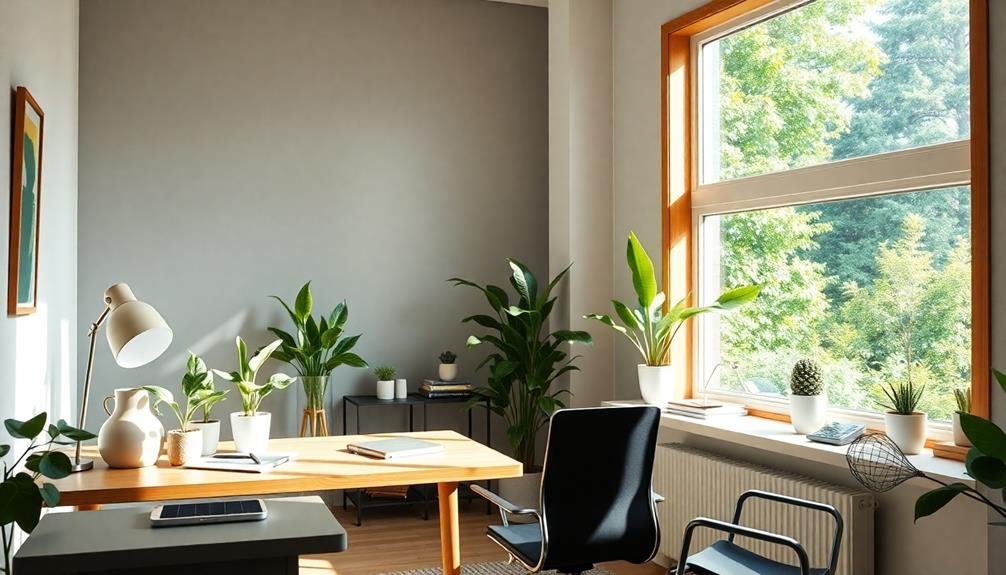
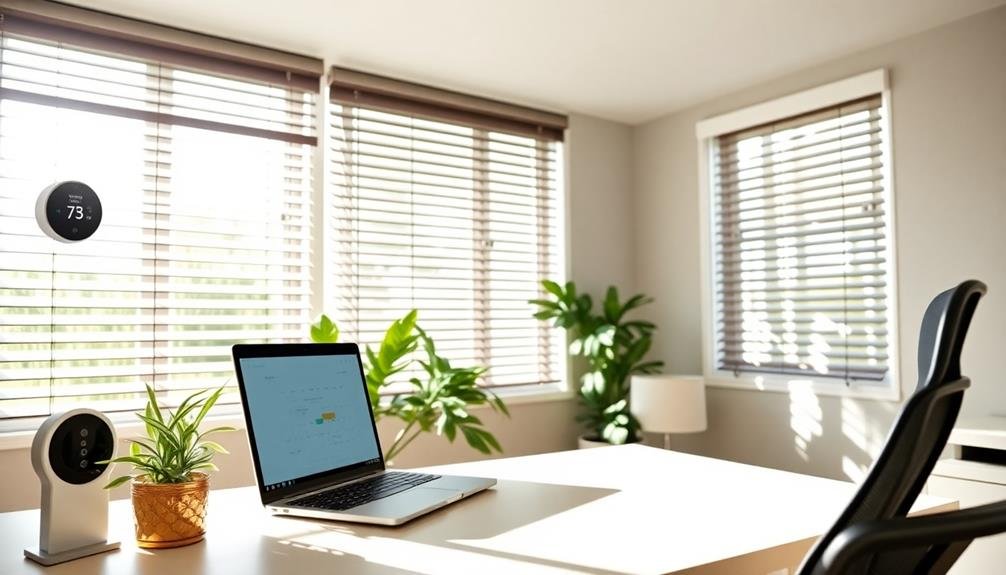
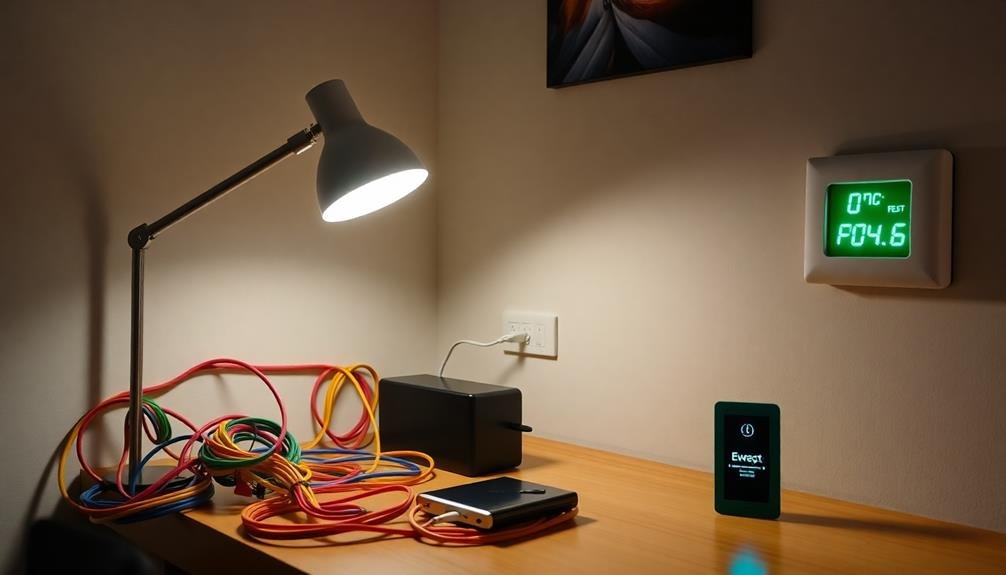
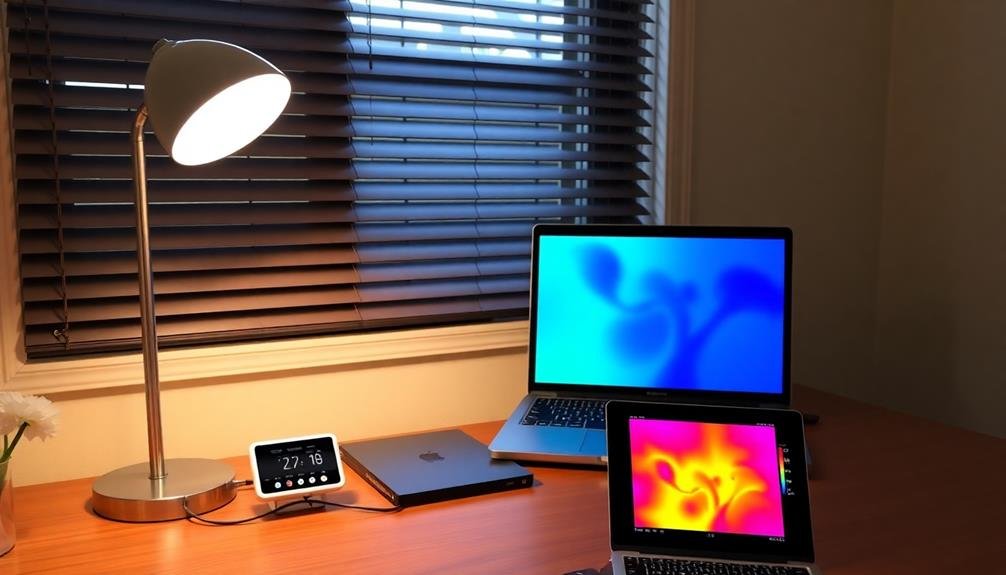
Leave a Reply